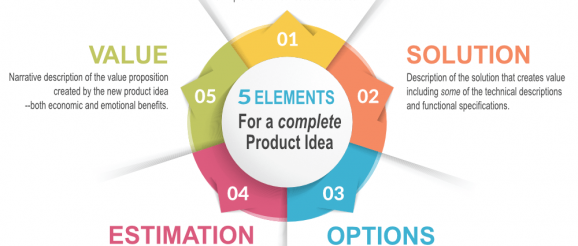Boost Your Product Innovation through Catalyst Workshops (part 1 of 3)

PRODUCT INNOVATION RESULTS
Below you’ll find the guiding principles, structure, theory, and practical advice for leading product innovation results in your organization. We hope you beg, borrow, steal, and modify heavily from our benchmark method called Product Concept Management (Catalyst). Catalyst is our method for clarifying the “fuzzy front-end” in product development. The “fuzzy front-end” represents the time and space between a thought (problem or solution) and the transformation into action by first converting the thought into a tangible concept.
What is a new product “idea”?
We are defining a thought as only a fragment of an idea. To have a complete idea to develop a new product with the Catalyst technique requires five elements. We’ll cover them in greater detail in our next article (part 2 of 3). For now, the five fragments include:
Prerequisites for developing and applying product innovation within your organization are few but important:
PRODUCT INNOVATION WORKSHOPS
We recommend the use of facilitated workshops that bring stakeholders, thought leaders, and implementors together with key designers and planners, under the guidance of professional facilitators. The network of individuals required in the analysis, design, and implementation of new products can be overwhelming. The guidance of a trained professional facilitator in Catalyst, new product development, and voice-of-the-customer assures the highest integrity with this proven method that should be adapted to you organization when seeking to support your mission and objectives.
The Catalyst product innovation approach provides substantial benefits (when compared to traditional interviewing and internal team analysis and design):
Within MG Rush, workshops are more than just a generic term. Each workshop aims to achieve specific results and to further the design and implementation method through a structured sequence.
This articles guides you when planning and conducting, facilitating, and managing the design and implementation of product innovation results by applying flexible structure.
WHEN SHOULD INNOVATION RESULTS WORKSHOPS BE USED?
We recommend that workshops be used in situations guided primarily by
The basic structure for the sequence of product innovation workshops is:
WHEN SHOULD WORKSHOPS NOT BE USED?
Workshops should not be used when:
CRITICAL SUCCESS FACTORS
Here are the factors critical to the success of your workshops and to the completion of product innovation results:
(WHEN) SHOULD PRODUCT INNOVATION WORKSHOPS BE USED INSTEAD OF WORK SESSIONS?
The Catalyst design typically requires a multi-functional, stratified team and is thus most often best served by workshops. However, work sessions are an acceptable substitute when:
PRODUCT INNOVATION RESULTS TECHNIQUES
For each workshop during product innovation design, and for each step in the workshop agenda, decide on the particular technique to support the appropriate introduction, discussion, and completion of the agenda item. Workshop tools supporting product innovation include:
SESSION LEADER RESPONSIBILITIES
A successful product innovation method depends on the effectiveness of the person assigned as facilitator – for team management, workshop management, and content delivery. The assignee is more than a facilitator; they are also the quality control officer for the NPD design process.
Successful workshops require special support, and a special temperament from the facilitator. Participants must feel comfortable, valued, safe, respected, and motivated if they are to contribute fully to the overall Catalyst design and during each workshop session. Their motivation will continue over to the assigned tasks when they feel that their efforts will be valued when returning back to the team in subsequent workshops.
The facilitator’s roles requires the following responsibilities to gain participants’ respect, following, trust, and cooperation:
FACILITATOR TECHNIQUES SUPPORTING PRODUCT INNOVATION
Conducting successful product innovation workshops requires a combination of skills, technique, and content knowledge. A successful facilitator requires high, sustained energy, intense concentration, and a good disposition. A sense of humor is useful, too. A facilitator is non-defensive, absorbs barbs of all descriptions, and stays focused on the challenge of delivering on the objectives of the workshop and goals of the product overall.
There are many skills and tools used by skilled, successful facilitators. A few are mentioned below, but are not intended to be a comprehensive inventory. Other techniques may evolve outside of the view of our Best Practices for Catalyst and product innovation and may also be useful for you.
FACILITATOR SKILLS
Examples of Preventions to Secure Innovation Results
Examples of Interventions to Secure Innovation Results
PART 2 OF 3
In our next article, we’ll provide the product innovation workshop design support tools and work products for the Catalyst method (or other NPD phases), such as:
Don’t ruin your career or reputation with bad meetings. Register now for a class or forward this to someone who should. Taught by world-class instructors, MG RUSH professional facilitation curriculum focuses on practice. Each student thoroughly practices and rehearses tools, methods, and approaches throughout the week. While some call this immersion, we call it the road to building impactful facilitation skills. #meetingresults
Our courses also provide an excellent way to earn up to 40 SEUs from the Scrum Alliance, 40 CDUs from IIBA, 40 Continuous Learning Points (CLPs) based on Federal Acquisition Certification Continuous Professional Learning Requirements using Training and Education activities, 40 Professional Development Units (PDUs) from SAVE International®, as well as 4.0 CEUs for other professions. (See individual class descriptions for details.) #facilitationtraining
Want a free 10-minute break timer? Signup for our once-monthly newsletter HERE and receive a timer along with four other of our favorite facilitation tools, free. #meetingdesign
